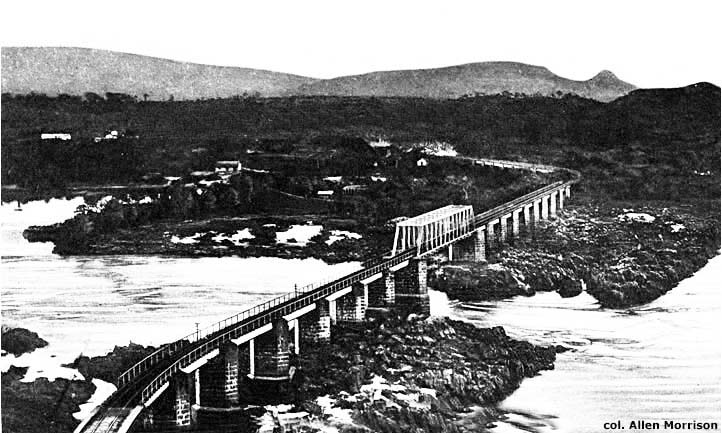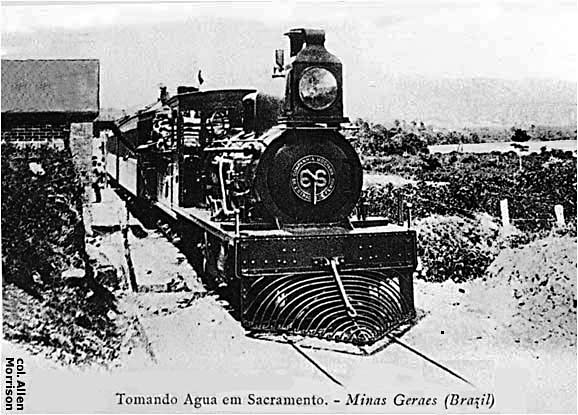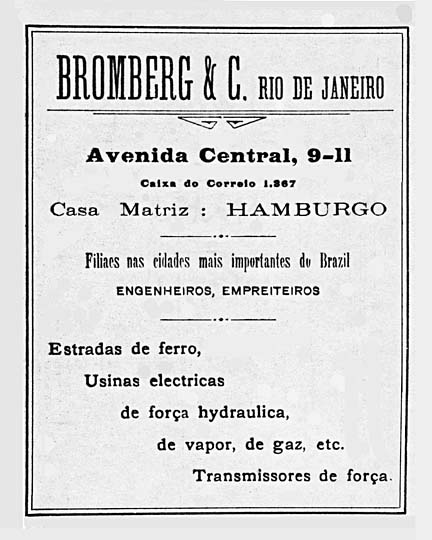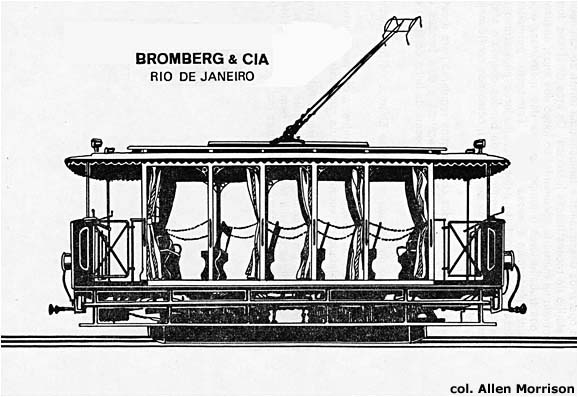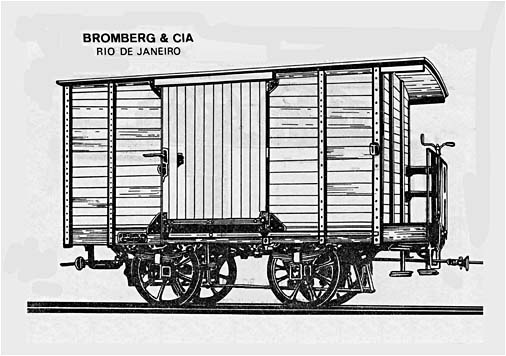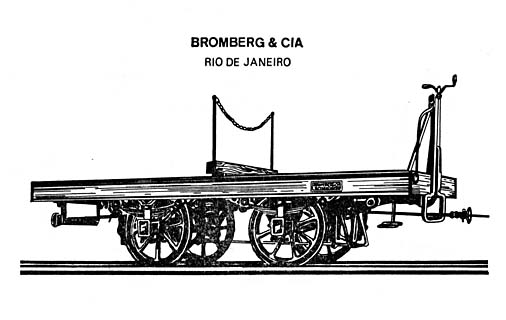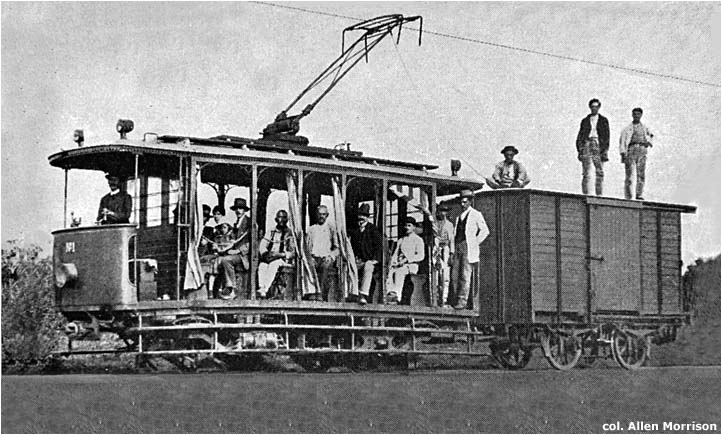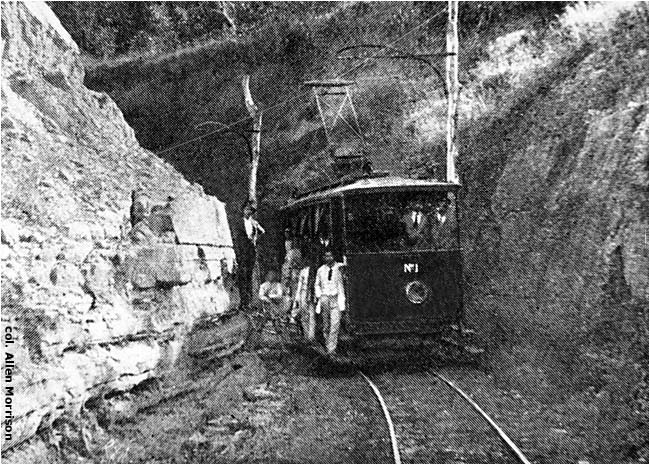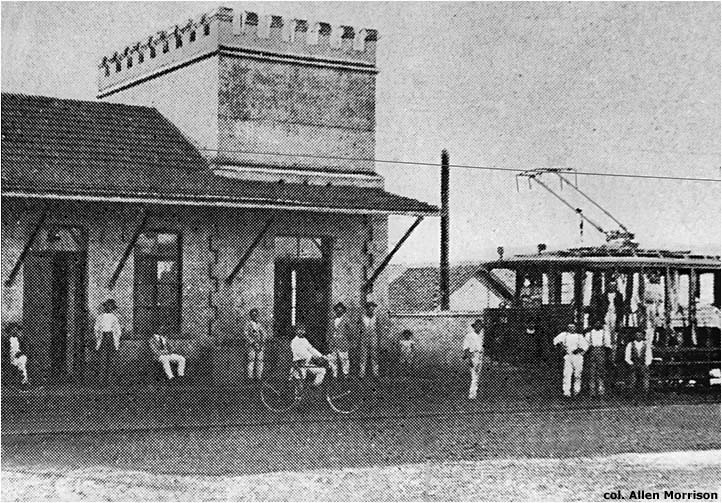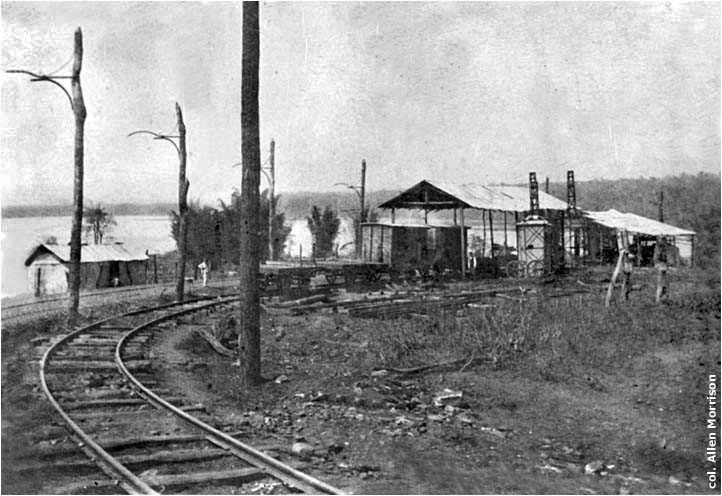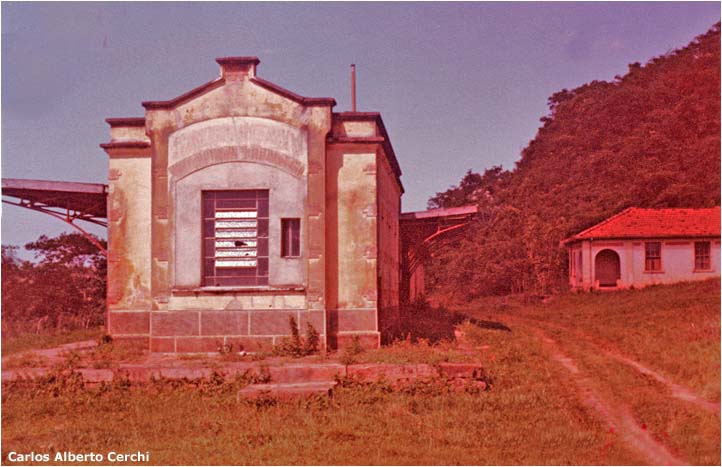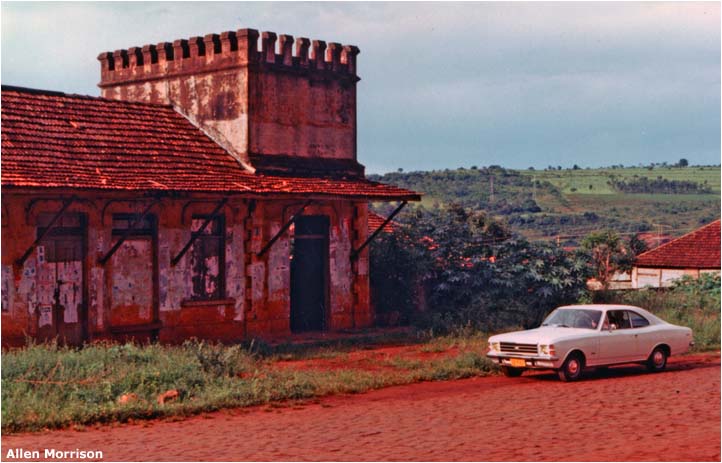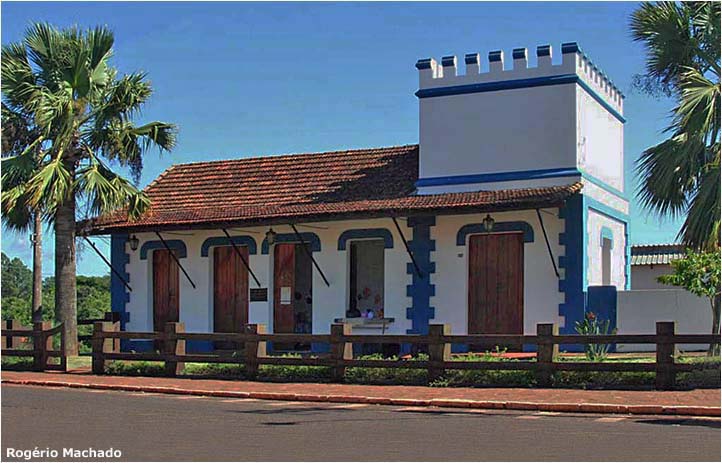The Electric Tramway of
SACRAMENTO
Minas Gerais state
BRAZIL
BY
Allen Morrison
|
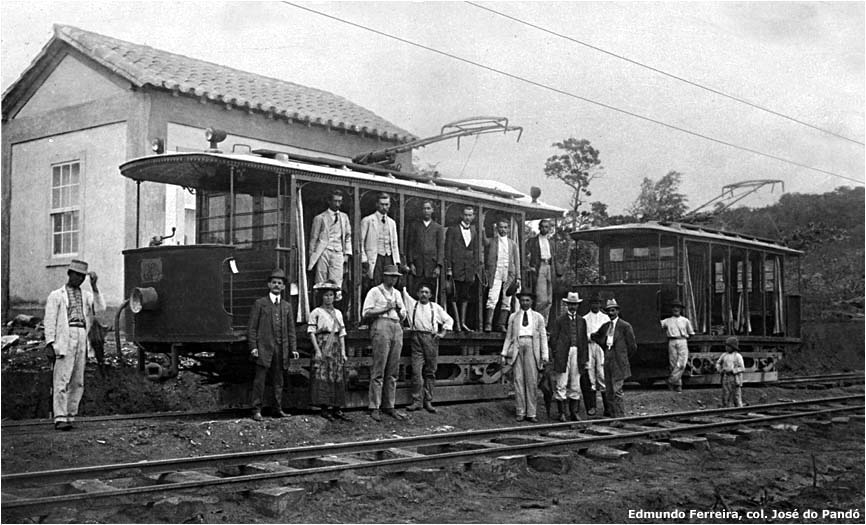
Free rides for passengers began in September 1913 and the Estrada de Ferro Elétrica Municipal de Sacramento formally inaugurated revenue service on its new tramway, between Sacramento and Cipó station, on 15 November 1913. A trip over the 14 km route took a half hour [Roberto Capri, 1916 - see BIBLIOGRAPHY]:
The tramway thrived and was of enormous benefit to residents, merchants and the local agriculture industry - not only around Sacramento but also the neighboring city of Araxá [see map #1]. The trailers were soon motorized. The climb up from the river valley involved 7% grades [Roberto Capri, 1916 - see BIBLIOGRAPHY]:
Many rode the trams to visit the Gruta dos Palhares, the largest sandstone cave in Latin America, near the Cipó end of the line ["GP" on map #3]. Brazilian aviation pioneer Alberto Santos Dumont came in 1931. The photograph below shows the terminal on Rua Joaquim Murtinho in Sacramento [see map #4] [Roberto Capri, 1916 - see BIBLIOGRAPHY]:
The following mysterious photograph, taken in 1913, provides the only known view of the EFEMS yards on the river [see map #3]. It shows two flat cars and two box cars, but no passenger cars and no overhead wire. And the traction poles are facing the wrong way! The track extreme left, of the same meter gauge, belongs to the Mogiana Railroad [Edmundo Ferreira, col. José do Pandó]:
Power demands increased: when the trams climbed the hill, house lights dimmed. Freight business decreased: in 1924 the Estrada de Ferro Oeste de Minas reached Araxá and a new paved highway opened to Uberaba. The Sacramento tramway is said to have carried its last passenger in October 1937 - although there are indications that operation continued into early 1938. In February 1939 Sacramento mayor José Ribeiro de Oliveira sold the line's 29.2 km of rail and 14.6 km of copper wire to a scrap dealer in São Paulo. The bridge over the Rio Grande closed in 1970 when its approaches were submerged by a dam. Trains continued to run from Jaguara to Uberaba until 1976. The photograph below shows Cipó station in 1982, six years after the railroad closed. The view is west. The railroad was on the left. The tramway presumably used that platform on the right [Carlos Alberto Cerchi]:
The next picture shows the station at the other end of the line in 1982 [see map #4]. Compare to the photograph above taken of the same place 65 years before [AM]:
Most traces of the tramway have disappeared today. Part of its right-of-way was rebuilt as an automobile road, but most of its path has been swallowed by weeds. After the author's visit in 1982 (and perhaps inspired by it) the tram station on Rua Joaquim Murtinho was restored and reopened as the Palácio das Artes, a museum and cultural center. This photograph was taken in April 2009 [Rogério Machado]:
BIBLIOGRAPHY Câmara Municipal de Sacramento. Sessão extraordinária de 14 de maio de 1910. Firm proposal for the financing and construction of an electric railway between Sacramento and Conquista. "Companhia Mogyana" in Brazil-Ferro-Carril (Rio de Janeiro), III 1911, p. 29. Electric railway planned from Conquista station to Sacramento. Minas Gerais, Serviço de Estatística Geral. Annuario de Minas Geraes, Anno IV (1911). Belo Horizonte, 1911. Plans for the electric railway, before involvement of Bromberg and Siemens-Schuckert, p. 171. "Minas Geraes" in Brazil-Ferro-Carril (Rio de Janeiro), 15 IX 1913, p. 411, and 30 IX 1913, p. 430. Progress on construction of the Sacramento electric railway. "Bond Eléctrico de Sacramento" in Lavoura e Comercio (Uberaba), 14 IX 1913, p. 1. A reporter takes a ride on the new line and, contrary to negative rumors, finds it in excellent condition. But so far only 10 of the 14 km are operable. Bromberg & Co., Hamburg. Rückblick/Retrospecto 1863-1913. Porto Alegre, 1913. Brochure describing its railroad work in Brazil. Drawings of the Sacramento vehicles (but no mention of their builder). Lloyd, Reginald. Twentieth Century Impressions of Brazil (also published in Portuguese as Impressões do Brasil no Século Vinte). London, 1913. An extraordinary 1,070-page survey of industry and culture in Brazil. Good, illustrated descriptions of "Bromberg & Co." on pp. 693, 813-816 and 844-845. The survey was unfortunately made too early to consider the Sacramento tramway. Estado de São Paulo, Comissão Geográfica e Geológica - Duprat & Cia. The "Rifaina" sheet, scale 1:100,000, published in 1914, shows the railroad route between Jaguara and Rifaina before it was submerged by construction of the dam. Roberto Capri. Minas Geraes e Seus Municípios. São Paulo, 1916. Several paragraphs and five extraordinary photographs of the "Viação Ferro-Carril Electrica" in Sacramento, pp. 33 and 100-106. Minas Gerais, Serviço de Estatística Geral. Annuário Estatístico de Minas Geraes. Belo Horizonte, 1921-1929. Annual surveys of "Ferro-carris": 1921 in vol. 3, pp. 568-570; 1922 in vol. 3, pp. 660-662. The 1921 edition reports 2 passenger cars and 6 freight cars on a 14 km line. The 1922 edition reports 2 passenger cars, 3 freight cars and 2 "carros mistos" (passenger & freight) on a 14.7 km line. Victor Silveira. Minas Gerais em 1925. Belo Horizonte, 1926. The Sacramento section, pp. 1397-1398, mentions the "importante linha de bondes electricos" and shows a passenger car with boxcar trailer. Minas Gerais. Serviço de Estatística Geral. Album Chorográphico Municipal do Estado de Minas Geraes. Belo Horizonte, 1927. "Sacramento" page shows tram engraving and (incorrect) map of route. Instituto Brasileiro de Geografia e Estatística, Superintendência de Cartografia. Carta do Brasil, 1:250,000. The "Uberaba" and "Franca" sheets, published in 1979, show the railroads in the region - except for the crossing of the Rio Grande, which was eliminated by the Jaguara dam. José Soares Bilharinho. "Linha de Bonds" in História da Medicina em Uberaba, vol. 3, pp. 1111-1121. Uberaba, 1983. Plans for an electric or steam-powered tramway in nearby Uberaba began in 1904. Long description, but, oddly, no mention of the Sacramento line. Waldemar Corrêa Stiel. História do Transporte Urbano no Brasil. Brasília, IV 1984. The Sacramento chapter, pp. 374-378, provides the first detailed history of tramway construction - although it reports that the line went to Conquista; the author apparently did not know that the destination was changed to Cipó! Interesting description of the brief use of ox power after a generator fire in 1914. Carlos Pedroso. "Bondes de Minas Antiga" in Lavoura e Comércio (Uberaba), 18 VIII 1984, p. 1. Nice text about the construction and inauguration of the Sacramento tramway. Survey of other tramways in the state and description of failed tramway plans in Uberaba. Carlos Alberto Cerchi. "O Bonde Elétrico de Sacramento" in Cosmovisão (Uberaba), VI 1985, pp. 37-45. Excellent description of the tramway, its construction, operation and abandonment. Three illustrations. "Inaugurados Praça e Palácio das Artes" and "José Luiz Enaltece Valor Cultural da Obra" in O Estado do Triângulo (Sacramento), 21 IX 1986, p. 8. Festive dedication of the new museum and cultural center in the former tramway station. Allen Morrison. The Tramways of Brazil: A 130-Year Survey. New York, 1989. The Sacramento chapter, p. 87 ff., contains four illustrations and a map. Carlos Alberto Cerchi. Os Bondes de Sacramento. Uberaba, 1991. Expansion of the author's article above. The definitive history and description (in Portuguese) of the electric tramway of Sacramento. 162 pages, many photographs, drawings and a map (adapted from my map in the book above). Antonio Augusto Gorni. Estrada de Ferro Eléctrica Municipal de Sacramento. 2001, revised 2003. Extremely detailed history and description of the Sacramento tramway. Rare documents about its liquidation and sale in 1939. Ralph Mennucci Giesbrecht. Estações Ferroviárias do Brasil. Superb survey of Brazil's railroad stations. The Sacramento page provides a detailed history not only of the Sacramento/Cipó station but also of the rail lines in the region. Several illustrations and my map from The Tramways of Brazil [see above].
The author wishes to express his profound gratitude to Sacramento resident Carlos Alberto Cerchi for the information and documents that he provided in the course of our eight-year correspondence (1983-1991). The documents included transcriptions of interviews that he conducted with Sacramento tram motorman Gumercindo de Paula Pontes and former Sacramento mayor Dr. José Ribeiro de Oliveira.
_______________________________________
See my index of If you have comments, criticism or suggestions, This site was placed online on 4 September 2012 Copyright © 2012-2112 Allen Morrison |
